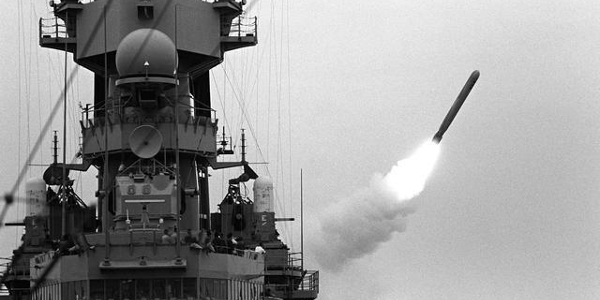
President Bush with Gulf War troops. Courtesy National Archives. Right: New York Stock Exchange in 1921 by Irving Underhill, Courtesy Library of Congress.
Click here to Sponsor the page and how to reserve your ad.
-
Timeline
1991 - Detail
January 12, 1991 - U.S. Congress passes a resolution authorizing the use of force to liberate Kuwait. Operation Desert Storm begins four days later with air strikes against Iraq. Iraq responds by sending eight Scud missiles into Israel.

Iraq had been on the State Sponsors of Terrorism list since December 29, 1979, so it was no surprise to the United States when Iraq continued its aggression in the region after the Iraq Iran War. Relations between the two nations had been a mixture of tug and pull, supporting it with munitions against Iran while realizing, even when they were taken off the Terror list, that Iraq was no friendly ally in the region. Heavily in debt after the Iran-Iraq war ended, Iraq refused to pay (mostly to Saudi Arabia and Kuwait) and reestablished its long claim to Kuwaiti territory. As part of the Ottoman Empire, Iraq thought the Basra region was theirs and did not agree to the 1922 partition that the United Kingdom had drawn for them as their protectorate. As oil prices dipped, Saddam Hussein, the Iraqi leader, blamed Kuwait in part for overproduction, use of the Rumaila fields, and threatened military action.
Negotiations were scheduled with Iraq demanding $10 billion from Kuwait. When Kuwait offered $9 billion, Saddam Hussein refused the concession, and ordered a military airstrike against Kuwait City on August 2, 1990. It was not going to be a fair fight; estimates of Iraqi military forces in 1988 indicated over 1.5 million troops and 484 planes. Kuwait had 16,000 troops and 80 planes. Within twelve hours, Iraq controlled the majority of Kuwait and the royal family had fled.
World Reaction
Immediate condemnation at the United Nations Security Council occured on August 2 with passage of Resolution 660; the Arab League followed with their own four days later. Economic sanctions and a naval blockade followed. Hussein wanted to tie any withdrawal from Kuwaiti territory to other problems in the Middle East. The United States refused to negotiate anything until Iraq removed its troops from Kuwait. On November 29, 1990, the United Nations passed Resolution 678, stating that Iraq had until January 15, 1991, to leave or face possible military action. A coaltion of thirty-four nations was formed to take that action.
Operation Desert Storm
On January 16, 1991, a large airstrike commenced against Iraq, lasting forty-two days. With over one hundred thousand airstrikes launched from Saudi Arabia and battleships in the Persian Gulf, coalition forces led by the United States destroyed the Iraqi Air Force, command and control structures, then military targets. Iraq responded by sending Scud missiles into Israel, causing casualties and destruction, attacked the Saudi Arabian city of Khafji, and continued to defend their positions.
Ground forces to liberate Kuwait entered the nation on February 24, 1991, with British and American troops leading the way. Over one hundred and fifty thousand coalition troops, with fifteen hundred tanks headed toward Kuwait City. By February 27, Saddam Hussein ordered his troops to leave Kuwait and the destruction of seven hundred and thirty-seven oil wells along the way. On February 24, coalition forces also crossed the Iraq-Kuwaiti border, pursuing Iraqi troops and moving to within one hundred fifty miles of Baghdad by February 28. A ceasefire was declared, coalition troops moved back to the border, and the liberation of Kuwait declared by President George H.W. Bush.

U.S. House Resolution Pursuant to U.N. Security Council Resolution 678
HJ 77 CPH, 102d CONGRESS, 1st Session, H. J. RES. 77
To authorize the use of United States Armed Forces pursuant to United Nations Security Council Resolution 678.
IN THE HOUSE OF REPRESENTATIVES, January 12, 1991
Mr. MICHEL (for himself, Mr. SOLARZ, Mr. FASCELL, Mr. BROOMFIELD, Mr. MONTGOMERY, Mr. ASPIN, Mr. DICKINSON, Mr. MURTHA, Mr. ACKERMAN, Mr. EDWARDS of Oklahoma, Mr. BERMAN, Mr. GALLEGLY, Mr. LEVINE of California, Mr. GILMAN, Mr. MCCURDY, Mr. HUNTER, Mr. SKELTON, Mr. HYDE, Mr. STENHOLM, Mr. LEACH of Iowa, Mr. TORRICELLI, Mr. LEWIS of California, Mr. SOLOMON, Mr. KYL, Mr. LAUGHLIN, Mr. DORNAN of California, Mr. MCMILLEN of Maryland, Mr. VOLKMER, Mr. LANTOS, Mrs. LLOYD, Mr. MCEWEN, and Mr. BLAZ) introduced the following joint resolution; which was considered and passed
JOINT RESOLUTION To authorize the use of United States Armed Forces pursuant to United Nations Security Council Resolution 678.
Whereas the Government of Iraq without provocation invaded and occupied the territory of Kuwait on August 2, 1990; Whereas both the House of Representatives (in H.J. Res. 658 of the 101st
Congress) and the Senate (in S. Con. Res. 147 of the 101st Congress) have condemned Iraq's invasion of Kuwait and declared their support for international action to reverse Iraq's aggression; Whereas, Iraq's conventional, chemical, biological, and nuclear weapons and ballistic missile programs and its demonstrated willingness to use weapons of mass destruction pose a grave threat to world peace; Whereas the international community has demanded that Iraq withdraw unconditionally and immediately from Kuwait and that Kuwait's independence
and legitimate government be restored;
Whereas the United Nations Security Council repeatedly affirmed the inherent right of individual or collective self-defense in response to the armed attack by Iraq against Kuwait in accordance with Article 51 of the United Nations Charter;
Whereas, in the absence of full compliance by Iraq with its resolutions, the United Nations Security Council in Resolution 678 has authorized member states of the United Nations to use all necessary means, after January 15, 1991, to uphold and implement all relevant Security Council resolutions and
to restore international peace and security in the area; and
Whereas Iraq has persisted in its illegal occupation of, and brutal aggression against Kuwait: Now, therefore, be it
Resolved by the Senate and House of Representatives of the United States of America in Congress assembled,
SECTION 1. SHORT TITLE.
This joint resolution may be cited as the `Authorization for Use of Military Force Against Iraq Resolution'.
SEC. 2. AUTHORIZATION FOR USE OF UNITED STATES ARMED FORCES.
(a) AUTHORIZATION- The President is authorized, subject to subsection (b), to use United States Armed Forces pursuant to United Nations Security Council Resolution 678 (1990) in order to achieve implementation of Security Council Resolutions 660, 661, 662, 664, 665, 666, 667, 669, 670, 674, and 677.
(b) REQUIREMENT FOR DETERMINATION THAT USE OF MILITARY FORCE IS NECESSARY - Before exercising the authority granted in subsection (a), the President shall make available to the Speaker of the House of Representatives and the President pro tempore of the Senate his determination that --
(1) the United States has used all appropriate diplomatic and other peaceful means to obtain compliance by Iraq with the United Nations Security Council resolutions cited in subsection (a); and (2) that those efforts have not been and would not be successful in obtaining such compliance.
(c) War Powers Resolution Requirements -
(1) SPECIFIC STATUTORY AUTHORIZATION- Consistent with section 8(a)
(1) of the War Powers Resolution, the Congress declares that this section is intended to constitute specific statutory authorization within the meaning of section 5(b) of the War Powers Resolution.
(2) APPLICABILITY OF OTHER REQUIREMENTS- Nothing in this resolution supersedes any requirement of the War Powers Resolution.
SEC. 3. REPORTS TO CONGRESS.
At least once every 60 days, the President shall submit to the Congress a summary on the status of efforts to obtain compliance by Iraq with the resolutions adopted by the United Nations Security Council in response to Iraq's aggression.
Photo above: 4th Tactical Fighter Wing on Operation Desert Storm Airfield, U.S. Air Force. Courtesy Wikipedia Commons. Courtesy Wikipedia Commons. Photo below: Tomahawk missile being launched off the USS Missouri, 1991, U.S. Navy. Courtesy Wikipedia Commons. Info source: Congress.gov; Wikipedia Commons.








